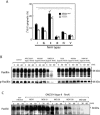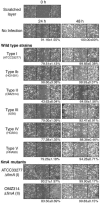Invasion of epithelial cells and proteolysis of cellular focal adhesion components by distinct types of Porphyromonas gingivalis fimbriae
- PMID: 16790749
- PMCID: PMC1489697
- DOI: 10.1128/IAI.01902-05
Invasion of epithelial cells and proteolysis of cellular focal adhesion components by distinct types of Porphyromonas gingivalis fimbriae
Abstract
Porphyromonas gingivalis fimbriae are classified into six types (types I to V and Ib) based on the fimA genes encoding FimA (a subunit of fimbriae), and they play a critical role in bacterial interactions with host tissues. In this study, we compared the efficiencies of P. gingivalis strains with distinct types of fimbriae for invasion of epithelial cells and for degradation of cellular focal adhesion components, paxillin, and focal adhesion kinase (FAK). Six representative strains with the different types of fimbriae were tested, and P. gingivalis with type II fimbriae (type II P. gingivalis) adhered to and invaded epithelial cells at significantly greater levels than the other strains. There were negligible differences in gingipain activities among the six strains; however, type II P. gingivalis apparently degraded intracellular paxillin in association with a loss of phosphorylation 30 min after infection. Degradation was blocked with cytochalasin D or in mutants with fimA disrupted. Paxillin was degraded by the mutant with Lys-gingipain disrupted, and this degradation was prevented by inhibition of Arg-gingipain activity by Nalpha-p-tosyl-l-lysine chloromethyl ketone. FAK was also degraded by type II P. gingivalis. Cellular focal adhesions with green fluorescent protein-paxillin macroaggregates were clearly destroyed, and this was associated with cellular morphological changes and microtubule disassembly. In an in vitro wound closure assay, type II P. gingivalis significantly inhibited cellular migration and proliferation compared to the cellular migration and proliferation observed with the other types. These results suggest that type II P. gingivalis efficiently invades epithelial cells and degrades focal adhesion components with Arg-gingipain, which results in cellular impairment during wound healing and periodontal tissue regeneration.
Figures






Similar articles
-
Virulence of Porphyromonas gingivalis is altered by substitution of fimbria gene with different genotype.Cell Microbiol. 2007 Mar;9(3):753-65. doi: 10.1111/j.1462-5822.2006.00825.x. Epub 2006 Nov 1. Cell Microbiol. 2007. PMID: 17081195
-
Entry of Porphyromonas gingivalis outer membrane vesicles into epithelial cells causes cellular functional impairment.Infect Immun. 2009 Nov;77(11):4761-70. doi: 10.1128/IAI.00841-09. Epub 2009 Sep 8. Infect Immun. 2009. PMID: 19737899 Free PMC article.
-
Molecular interaction of Porphyromonas gingivalis with host cells: implication for the microbial pathogenesis of periodontal disease.J Periodontol. 2003 Jan;74(1):90-6. doi: 10.1902/jop.2003.74.1.90. J Periodontol. 2003. PMID: 12593602 Review.
-
Transcriptional profiling of human smooth muscle cells infected with gingipain and fimbriae mutants of Porphyromonas gingivalis.Sci Rep. 2016 Feb 24;6:21911. doi: 10.1038/srep21911. Sci Rep. 2016. PMID: 26907358 Free PMC article.
-
Disruption of epithelial barrier and impairment of cellular function by Porphyromonas gingivalis.Front Biosci. 2007 May 1;12:3965-74. doi: 10.2741/2363. Front Biosci. 2007. PMID: 17485350 Review.
Cited by
-
Effect of tobacco on periodontal disease and oral cancer.Tob Induc Dis. 2019 May 9;17:40. doi: 10.18332/tid/106187. eCollection 2019. Tob Induc Dis. 2019. PMID: 31516483 Free PMC article. Review.
-
Histidine kinase-mediated production and autoassembly of Porphyromonas gingivalis fimbriae.J Bacteriol. 2010 Apr;192(7):1975-87. doi: 10.1128/JB.01474-09. Epub 2010 Jan 29. J Bacteriol. 2010. PMID: 20118268 Free PMC article.
-
Contribution of Streptococcus mutans Strains with Collagen-Binding Proteins in the Presence of Serum to the Pathogenesis of Infective Endocarditis.Infect Immun. 2017 Nov 17;85(12):e00401-17. doi: 10.1128/IAI.00401-17. Print 2017 Dec. Infect Immun. 2017. PMID: 28947650 Free PMC article.
-
Oral Mucosal Epithelial Cells.Front Immunol. 2019 Feb 14;10:208. doi: 10.3389/fimmu.2019.00208. eCollection 2019. Front Immunol. 2019. PMID: 30837987 Free PMC article. Review.
-
Porphyromonas gingivalis fimbrial protein Mfa5 contains a von Willebrand factor domain and an intramolecular isopeptide.Commun Biol. 2021 Jan 25;4(1):106. doi: 10.1038/s42003-020-01621-w. Commun Biol. 2021. PMID: 33495563 Free PMC article.
References
-
- Amano, A., I. Nakagawa, N. Okahashi, and N. Hamada. 2004. Variations of Porphyromonas gingivalis fimbriae in relation to microbial pathogenesis. J. Periodontal Res. 39:136-142. - PubMed
-
- Amano, A., M. Kuboniwa, I. Nakagawa, S. Akiyama, S., I. Morisaki, and S. Hamada. 2000. Prevalence of specific genotypes of Porphyromonas gingivalis fimA and periodontal health status. J. Dent. Res. 79:1664-1668. - PubMed
-
- Belton, C. M., K. T. Izutsu, P. C. Goodwin, Y. Park, and R. J. Lamont. 1999. Fluorescence image analysis of the association between Porphyromonas gingivalis and gingival epithelial cells. Cell. Microbiol. 1:215-223. - PubMed
-
- Chen, Z., C. A. Casiano, and H. M. Fletcher. 2001. Protease-active extracellular protein preparations from Porphyromonas gingivalis W83 induce N-cadherin proteolysis, loss of cell adhesion, and apoptosis in human epithelial cells. J. Periodontol. 72:641-650. - PubMed
Publication types
MeSH terms
Substances
LinkOut - more resources
Full Text Sources
Miscellaneous

